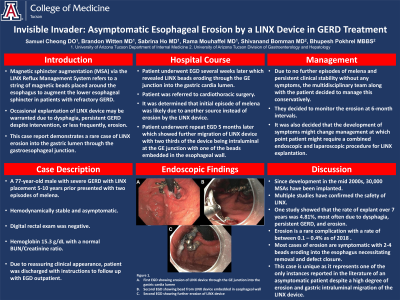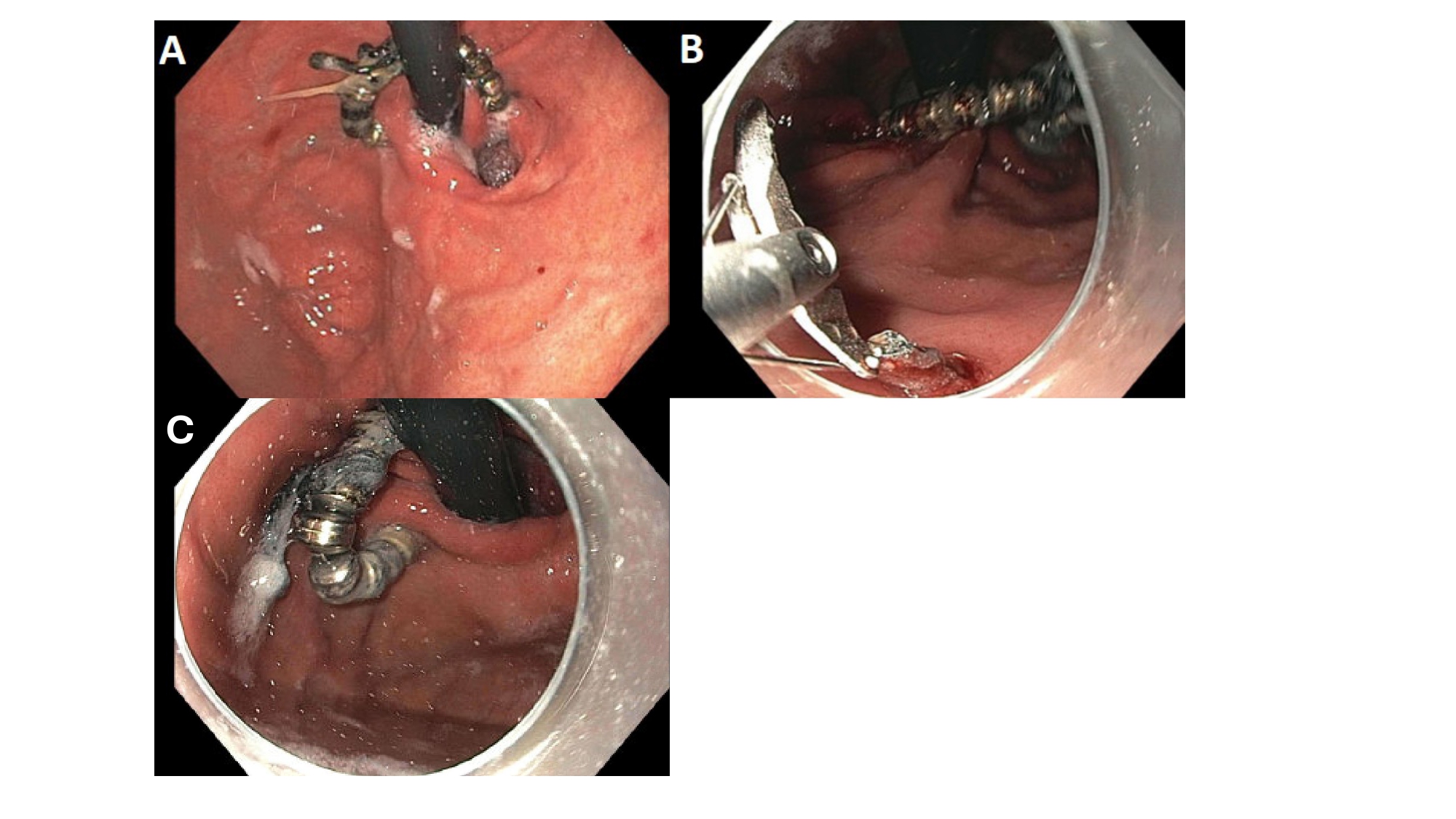Monday Poster Session
Category: Esophagus
P2293 - Invisible Invader: Asymptomatic Esophageal Erosion by a LINX Device in GERD Treatment
Monday, October 28, 2024
10:30 AM - 4:00 PM ET
Location: Exhibit Hall E

Has Audio

Samuel H. Cheong, DO
Banner - University of Arizona
Tucson, AZ
Presenting Author(s)
Samuel H. Cheong, DO1, Brandon Witten, MD2, Sabrina Ho, MD1, Rama Mouhaffel, MD1, Shivanand Bomman, MD2, Bhupesh Pokhrel, MBBS1
1Banner - University of Arizona, Tucson, AZ; 2University of Arizona College of Medicine, Tucson, AZ
Introduction: Magnetic sphincter augmentation (MSA) via the LINX® Reflux Management System refers to a string of magnetic beads placed around the esophagus to augment the lower esophageal sphincter in patients with refractory GERD. Occasional explantation of LINX device may be required due to dysphagia, continued GERD despite intervention, or less frequently, erosion. We present a rare case of LINX erosion into the gastric lumen through the gastroesophageal (GE) junction.
Case Description/Methods: A 77-year-old male with severe GERD with LINX placement 5-10 years prior presented for emergency medical evaluation following two episodes of melena. Patient was otherwise asymptomatic and hemodynamically stable. Digital rectal exam was negative; hemoglobin was 15.3 g/dL with a normal BUN/Creatinine ratio. Due to reassuring clinical appearance he was discharged with instructions to follow up with EGD outpatient.
Patient underwent EGD several weeks later which revealed LINX beads eroding through the GE junction into the gastric cardia lumen. Patient was then referred to cardiothoracic surgery. It was determined that the initial episode of melena was likely due to another source versus erosion by the LINX device. Five months later, repeat EGD showed further migration with two thirds of the device being intraluminal at the GE junction with one of the beads embedded in the esophageal wall. Due to no further episodes of melena and persistent clinical stability without any symptoms the multidisciplinary team along with the patient decided to manage this conservatively with monitoring the erosion at 6-month intervals. However it was also decided that the development of symptoms might change management at which point he might require a combined endoscopic and laparoscopic procedure for LINX explantation.
Discussion: Since development in the mid 2000s, 30,000 MSAs have been implanted. Multiple studies confirm the safety of LINX. One study showed that the rate of explant over 7 years was 4.81%, most often due to dysphagia, persistent GERD, and finally erosion. Erosion is a rare complication with a rate between 0.1 and 0.4% as of 2018 and is associated with smaller devices. Most cases of erosion are symptomatic with 2-4 beads eroding into the esophagus necessitating removal and defect closure. Our case is unique as it represents one of the only instances reported in the literature of an asymptomatic patient despite a high degree of erosion and gastric intraluminal migration of the LINX device.

Disclosures:
Samuel H. Cheong, DO1, Brandon Witten, MD2, Sabrina Ho, MD1, Rama Mouhaffel, MD1, Shivanand Bomman, MD2, Bhupesh Pokhrel, MBBS1. P2293 - Invisible Invader: Asymptomatic Esophageal Erosion by a LINX Device in GERD Treatment, ACG 2024 Annual Scientific Meeting Abstracts. Philadelphia, PA: American College of Gastroenterology.
1Banner - University of Arizona, Tucson, AZ; 2University of Arizona College of Medicine, Tucson, AZ
Introduction: Magnetic sphincter augmentation (MSA) via the LINX® Reflux Management System refers to a string of magnetic beads placed around the esophagus to augment the lower esophageal sphincter in patients with refractory GERD. Occasional explantation of LINX device may be required due to dysphagia, continued GERD despite intervention, or less frequently, erosion. We present a rare case of LINX erosion into the gastric lumen through the gastroesophageal (GE) junction.
Case Description/Methods: A 77-year-old male with severe GERD with LINX placement 5-10 years prior presented for emergency medical evaluation following two episodes of melena. Patient was otherwise asymptomatic and hemodynamically stable. Digital rectal exam was negative; hemoglobin was 15.3 g/dL with a normal BUN/Creatinine ratio. Due to reassuring clinical appearance he was discharged with instructions to follow up with EGD outpatient.
Patient underwent EGD several weeks later which revealed LINX beads eroding through the GE junction into the gastric cardia lumen. Patient was then referred to cardiothoracic surgery. It was determined that the initial episode of melena was likely due to another source versus erosion by the LINX device. Five months later, repeat EGD showed further migration with two thirds of the device being intraluminal at the GE junction with one of the beads embedded in the esophageal wall. Due to no further episodes of melena and persistent clinical stability without any symptoms the multidisciplinary team along with the patient decided to manage this conservatively with monitoring the erosion at 6-month intervals. However it was also decided that the development of symptoms might change management at which point he might require a combined endoscopic and laparoscopic procedure for LINX explantation.
Discussion: Since development in the mid 2000s, 30,000 MSAs have been implanted. Multiple studies confirm the safety of LINX. One study showed that the rate of explant over 7 years was 4.81%, most often due to dysphagia, persistent GERD, and finally erosion. Erosion is a rare complication with a rate between 0.1 and 0.4% as of 2018 and is associated with smaller devices. Most cases of erosion are symptomatic with 2-4 beads eroding into the esophagus necessitating removal and defect closure. Our case is unique as it represents one of the only instances reported in the literature of an asymptomatic patient despite a high degree of erosion and gastric intraluminal migration of the LINX device.

Figure: A. First EGD showing erosion of LINX device through the GE junction into the gastric cardia lumen. B. Second EGD showing bead from LINX device embedded in esophageal wall. C. Second EGD showing further erosion of LINX device.
Disclosures:
Samuel Cheong indicated no relevant financial relationships.
Brandon Witten indicated no relevant financial relationships.
Sabrina Ho indicated no relevant financial relationships.
Rama Mouhaffel indicated no relevant financial relationships.
Shivanand Bomman indicated no relevant financial relationships.
Bhupesh Pokhrel indicated no relevant financial relationships.
Samuel H. Cheong, DO1, Brandon Witten, MD2, Sabrina Ho, MD1, Rama Mouhaffel, MD1, Shivanand Bomman, MD2, Bhupesh Pokhrel, MBBS1. P2293 - Invisible Invader: Asymptomatic Esophageal Erosion by a LINX Device in GERD Treatment, ACG 2024 Annual Scientific Meeting Abstracts. Philadelphia, PA: American College of Gastroenterology.
